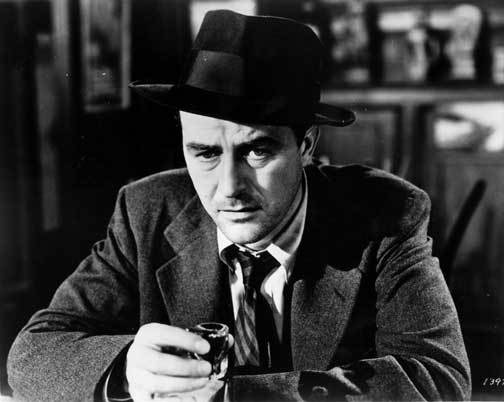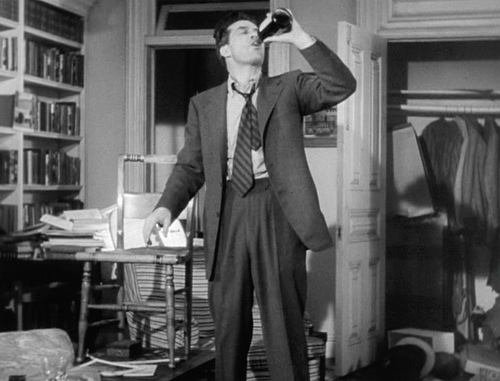 The portrayal of alcoholism and drug addiction in film and television has evolved over time. Early depictions of drinking in films tended to be comic and unrealistic. W. C. Fields is one example. Another is The Thin Man series (1934 – 1947), in which Nick and Nora Charles drink basically non-stop, but never seem impaired. At most they get mildly tipsy, which only makes them wittier, more charming and attractive.
The portrayal of alcoholism and drug addiction in film and television has evolved over time. Early depictions of drinking in films tended to be comic and unrealistic. W. C. Fields is one example. Another is The Thin Man series (1934 – 1947), in which Nick and Nora Charles drink basically non-stop, but never seem impaired. At most they get mildly tipsy, which only makes them wittier, more charming and attractive.
As recently as 1981, in Arthur, Dudley Moore’s character is of the “lovable drunk” variety. His constant drunkenness is seen as comic rather than a source of concern. In Cat Ballou (1965), Lee Marvin won an Academy Award as a washed up gunfighter, a falling-down drunk played for laughs; even his horse got drunk.
The Lost Weekend (1945) was, to my knowledge, the first dramatic film to deal seriously with alcoholism. Don Birnham, an aspiring writer in New York City, is a drunk. His girlfriend and brother are enablers despite their desire to help him. Though Alcoholics Anonymous isn’t mentioned, the disease concept is acknowledged when Don’s girlfriend states that he has a sickness. The film was a major success, winning Academy Awards for Best Picture, as well as Director (Billy Wilder), Actor (Ray Milland), Screenplay (Wilder and Charles Brackett).
Ten years later, The Man with the Golden Arm (1955), the first American film to deal openly with drug addictionwas released without the MPAA seal of approval, as this had been a taboo subject for films since the 1930s. And while this film opened the door, films depicting substance abuse continued to be mainly about alcoholism until the 1970s.
 Since then many films have dealt with alcoholism and drug addiction in a variety of ways. In films of the 1950s, substance abuse is almost always the main subject of the story, which usually ends with the protagonist either being destroyed by his or her addiction or in recovery from it (often not a 12-Step program of recovery, though Alcoholics Anonymous progressively becomes more of a presence). Days of Wine and Roses (1962) gives us both of these endings, with Jack Lemmon’s character surviving in recovery, while his wife (Lee Remick) continues her downward spiral.
Since then many films have dealt with alcoholism and drug addiction in a variety of ways. In films of the 1950s, substance abuse is almost always the main subject of the story, which usually ends with the protagonist either being destroyed by his or her addiction or in recovery from it (often not a 12-Step program of recovery, though Alcoholics Anonymous progressively becomes more of a presence). Days of Wine and Roses (1962) gives us both of these endings, with Jack Lemmon’s character surviving in recovery, while his wife (Lee Remick) continues her downward spiral.
Over the last twenty-five years or so, there have been real changes in the way alcoholism and drug addiction have been portrayed in film and television. This may be due largely to a greater awareness of the realities involved, as substance abuse becomes less stigmatized and stereotyped, and the public learns more about 12-Step recovery programs, rehabs, the disease concept, etc. One result of this is that a character’s alcoholism often becomes less the main subject of the story and more a part of the character’s background, often a critical determining factor of his or her behavior.
Alcoholism or drug use is presented as a lifestyle in films such as Ironweed (1984), Barfly (1987), and Factotum (2005). Recovery is not an issue or an option. We certainly see the effects alcohol and drugs have on these characters, but this is presented as a fact of life for them. This is even true on the long-running TV series The Simpsons. Homer is addicted to food and booze, and proud of it. His friend Barney is presented as a totally terminal alcoholic, but no problem, it’s just the way he is.
Trees Lounge (1996), with Steve Buscemi as writer, director and star, is a particularly strong film. It takes the subject of a drinking life head on. The world that Buscemi’s character Tommy inhabits feels totally accurate. Tommy literally lives above the Trees Lounge bar in suburban Long Island, and seemingly spends every waking moment hanging out in the bar, when he’s not at his day job driving an ice-cream truck. The details of his day-to-day existence are at once tragic and mundane. Charles Bukowski would be at home here.
 While not about addiction per se, in Affliction(1997) a key component of the story deals with generational alcoholism, set in a snow-covered New Hampshire town. In the film, the alcoholism and behavior of Glen Whitehouse (James Coburn in a truly powerhouse performance) is passed down to his son Wade (Nick Nolte), and is seen as the root cause of dysfunction in the family. We see how Wade’s often-disastrous actions, large and small, are the direct result of his totally stunted upbringing by an alcoholic father.
While not about addiction per se, in Affliction(1997) a key component of the story deals with generational alcoholism, set in a snow-covered New Hampshire town. In the film, the alcoholism and behavior of Glen Whitehouse (James Coburn in a truly powerhouse performance) is passed down to his son Wade (Nick Nolte), and is seen as the root cause of dysfunction in the family. We see how Wade’s often-disastrous actions, large and small, are the direct result of his totally stunted upbringing by an alcoholic father.
In a telling scene, Wade’s younger brother Rolfe (Willem Dafoe) has returned from Boston for their mother’s funeral. He remembers an incident from their childhood when Glen had physically injured Wade. Rolfe says, “After I heard, I became real careful around Pop. I was a careful child. I became a careful adult. At least I was never afflicted by that man’s violence.” To which Wade responds, laughing, “That’s what you think.”
Since the 1990s, alcoholic characters have appeared on TV shows with increasing frequency. For example, on NYPD Blue, the alcoholism of Andy Sipowitz and Diane Russell is key to their character development, and important to the plotlines. For Lenny Briscoe on Law and Order, Capt. Cragen on Law and Order: Special Victims Unit, and Fritz Howard on The Closer, it functions more as background for their characters.
In some instances, giving characters alcoholic histories may simply be a device, an easy way to make them seem more interesting. But it can also be integral to the character and the story. In either case, I think it reflects the greater awareness and understanding of substance abuse I mentioned earlier. To the extent that these characters are seen as recognizable human beings instead of stereotypes is a definite step forward.
Other films and TV programs worth checking out that depict alcohol and drug use to one degree or another include the following:
- Come Back, Little Sheba (1952)
- The Country Girl (1954)
- I’ll Cry Tomorrow (1955)
- On the Bowery (1956)
- Who’s Afraid of Virginia Woolf (1966)
- The Panic in Needle Park (1971)
- Born to Win (1971)
- Fat City (1972)
- Tender Mercies (1983)
- Under the Volcano (1984)
- Withnail & I (1987)
- Clean and Sober (1988)
- Drugstore Cowboy (1989)
- My Name Is Bill W. (1989 – TV)
- Shakes the Clown (1991)
- When a Man Loves a Woman (1994)
- Leaving Las Vegas (1995)
- Drunks (1995)
- Trainspotting (1996)
- Fear and Loathing in Las Vegas (1998)
- My Name Is Joe (1999)
- Requiem for a Dream (2000)
- The Sopranos (1999 – 2007, HBO)
- The Wire (2002 – 2008, HBO)
- You Kill Me (2007)
- Crazy Heart (2009)
More information about these and the many other films and TV programs that deal with substance abuse, and their availability on home video, may be found online. I know I’ve just skimmed the surface in this piece, so let me know what I’ve left out. – Ted Hicks




A very nice essay. You missed two of my favorites, though: PANIC IN NEEDLE PARK with Al Pacino and ADDICT with George Segal. It is interesting to see how society has changed in its attitude towards drinking and dope, over the years. Remember how lenient the cops were with Cary Grant in NOTORIOUS?
Actually, PANIC IN NEEDLE PARK is in the list of films at the end of the post. I’d seen it years ago, then saw it again a couple of years ago. Tough, uncompromising film, didn’t like watching it, but it sure does the job. I think the George Segal film you’re referring to is BORN TO WIN (1971), which should definitely be on the list. Robert De Niro is in it, too. It was directed by Ivan Passer, who also made CUTTER’S WAY in 1981 and LAW AND DISORDER in 1974, both very good films. You mention NOTORIOUS, and you know, I’ve never seen it. This is a movie I have to catch up with. Thanks for you comments!
By God, Ted, there it was, PANIC IN NEEDLE PARK. I must have been drunk when I first read the blog. And, we’re talking about the same George Segal movie, because I remember that Robert DeNiro was the cop chasing him and putting money in the clothes-drier to spin Segal the hapless junkie around in circles. But I had the name of the movie wrong: no wonder I’ve never found it on videotape or DVD. D’oh!
Really interesting post, I think another film portraying a heavily drug-involved lifestyle brilliantly is TRAINSPOTTING (1996), which I don’t think you have mentioned, and is a fantastic film. It is so grim and harrowing, made all the more compelling considering that it is based on a semi-biographical novel.
A memorable episode of the Mary Tyler Moore show dealt with the remodeling of the TV station’s offices. Mr. Grant got a new glass desk. The problem was he had always kept his bottle of bourbon in the lower right-hand drawer of his old wooden desk and there was no place for the bottle in the new set up. There’s a metaphor in there somewhere.
HILL STREET BLUES had a funny episode where all the cops got stoned – and so did BARNEY MILLER. If only life was as much fun as television.
Pingback: The Conscience of Television | Communications in a Global Age D
Unless you include Willie Ross in Rita, Sue and Bob Too, your list is incomplete and plain wrong.
Just checked and see that this film was released in NYC in July 1987. I didn’t see it, though it looks very interesting. There are no doubt many films I hadn’t seen when I posted this piece in 2012 that would qualify to be included. That admittedly make my list incomplete, but not necessarily “wrong” for that. But thanks for reading and for your comment.